BMP3004: Exploring Motivation, Experiences in the World of Work
VerifiedAdded on 2023/06/15
|8
|2016
|308
Essay
AI Summary
This essay delves into the complexities of employee motivation within the 'World of Work,' examining both intrinsic and extrinsic factors that drive individuals. It utilizes Maslow's Hierarchy of Needs to understand the psychological drivers behind work, such as the need for safety, belonging, esteem, and self-actualization. The essay identifies key motivators like salary, promotion opportunities, and a positive work environment, while also addressing negative experiences such as high workloads and feelings of insecurity. Furthermore, it proposes strategies for organizations to mitigate these negative factors, emphasizing the importance of a supportive organizational culture and robust safety measures. The analysis provides a comprehensive overview of the multifaceted nature of employee motivation and its impact on organizational success.
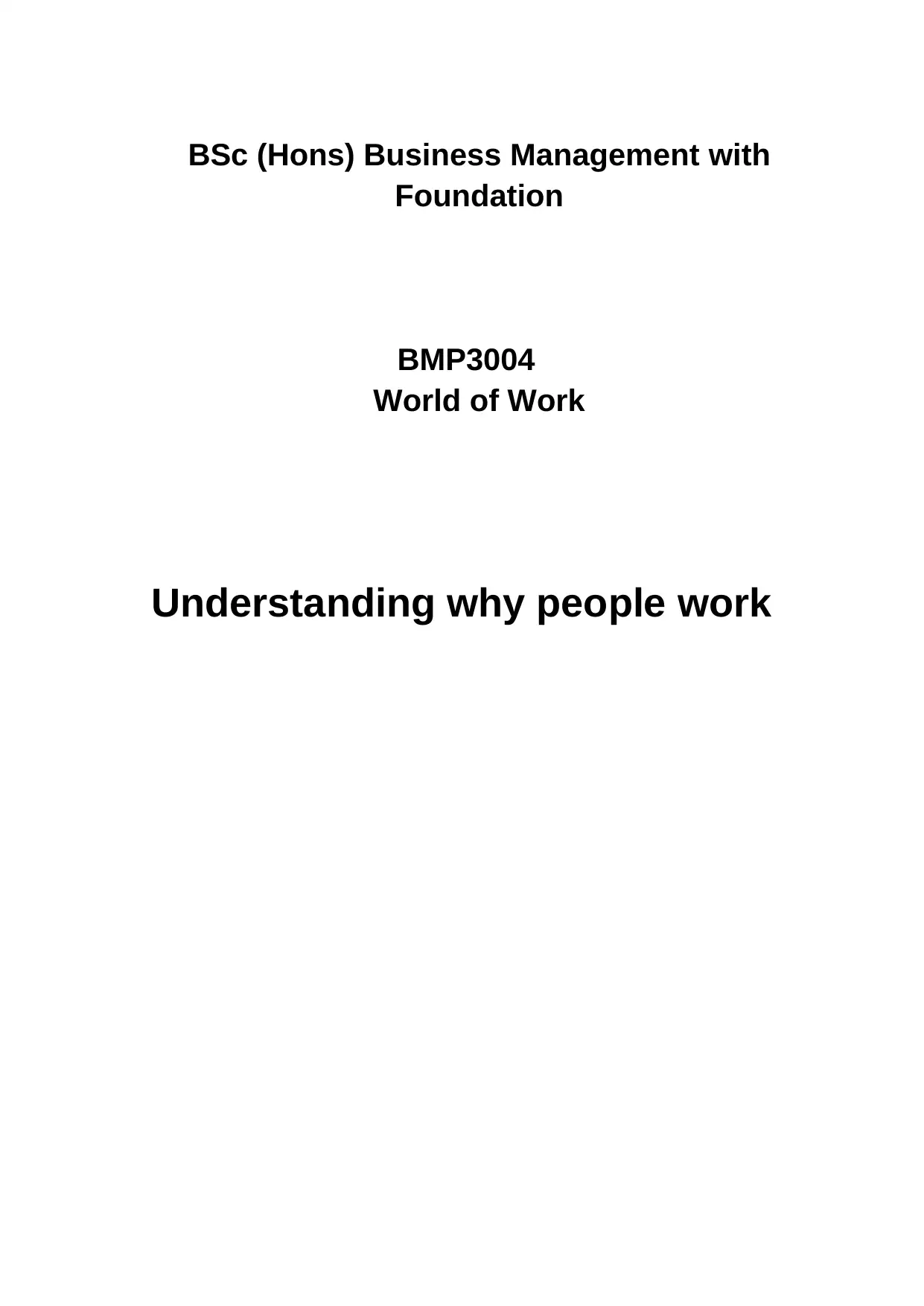
BSc (Hons) Business Management with
Foundation
BMP3004
World of Work
Understanding why people work
Foundation
BMP3004
World of Work
Understanding why people work
Paraphrase This Document
Need a fresh take? Get an instant paraphrase of this document with our AI Paraphraser
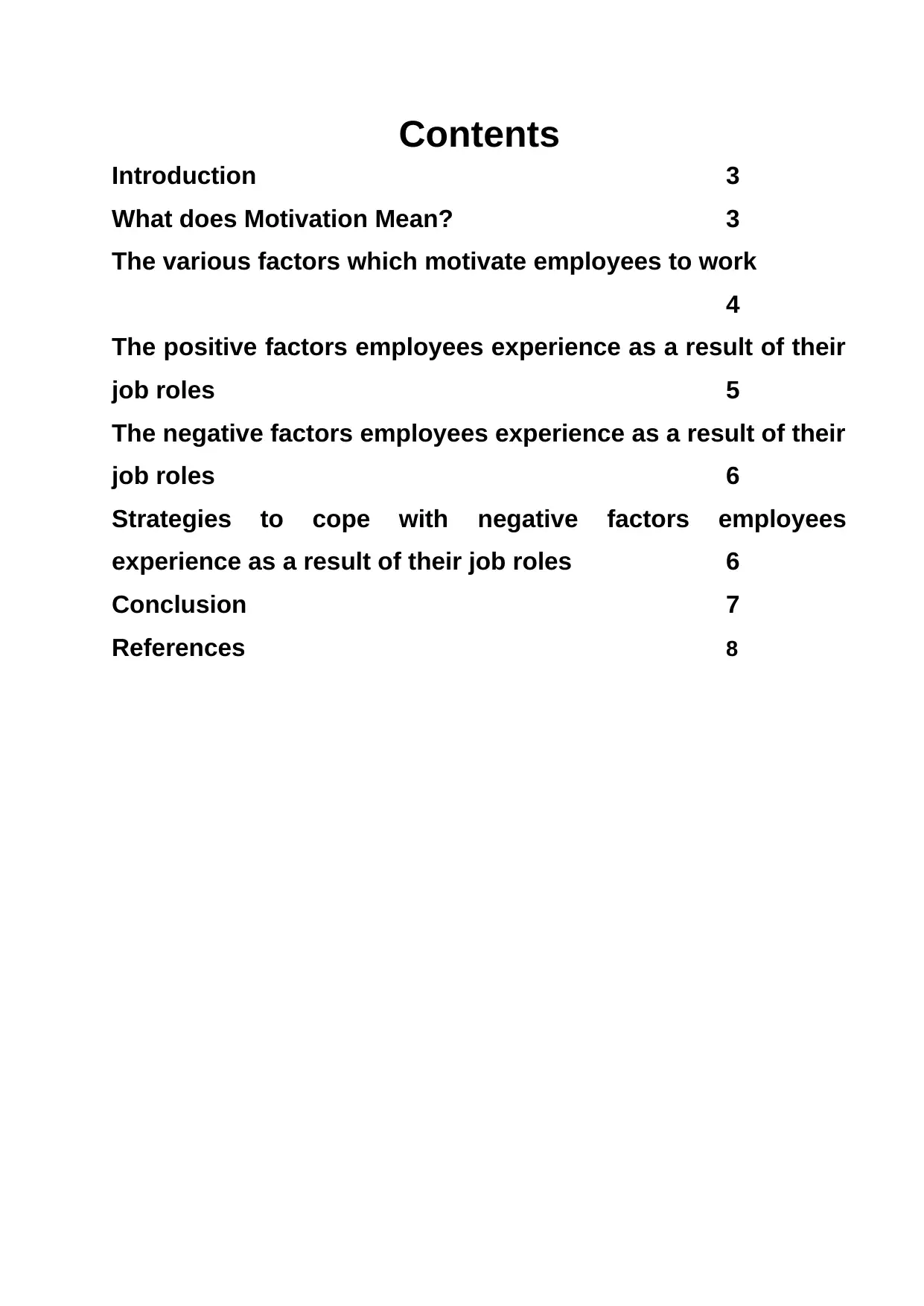
Contents
Introduction 3
What does Motivation Mean? 3
The various factors which motivate employees to work
4
The positive factors employees experience as a result of their
job roles 5
The negative factors employees experience as a result of their
job roles 6
Strategies to cope with negative factors employees
experience as a result of their job roles 6
Conclusion 7
References 8
Introduction 3
What does Motivation Mean? 3
The various factors which motivate employees to work
4
The positive factors employees experience as a result of their
job roles 5
The negative factors employees experience as a result of their
job roles 6
Strategies to cope with negative factors employees
experience as a result of their job roles 6
Conclusion 7
References 8
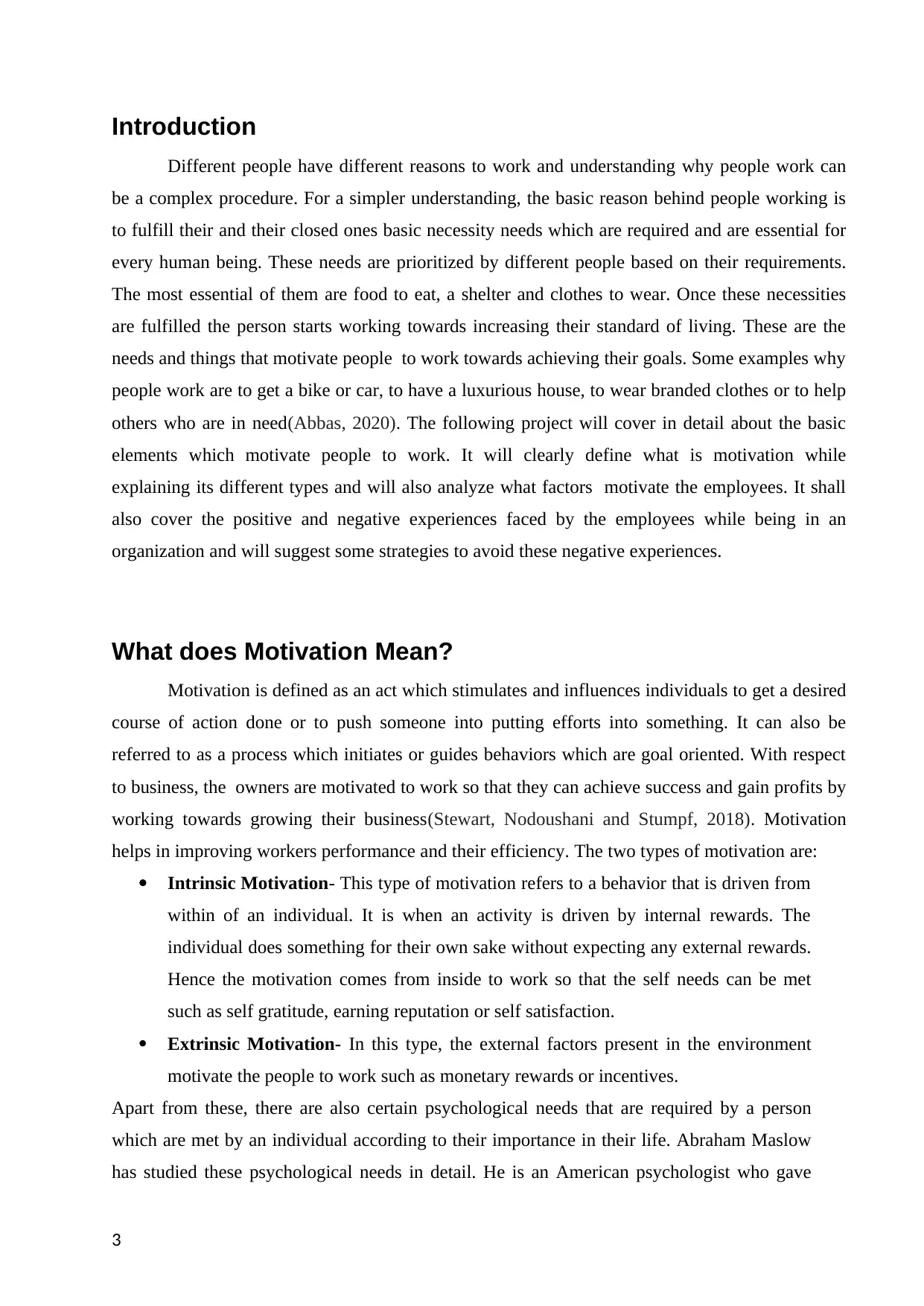
Introduction
Different people have different reasons to work and understanding why people work can
be a complex procedure. For a simpler understanding, the basic reason behind people working is
to fulfill their and their closed ones basic necessity needs which are required and are essential for
every human being. These needs are prioritized by different people based on their requirements.
The most essential of them are food to eat, a shelter and clothes to wear. Once these necessities
are fulfilled the person starts working towards increasing their standard of living. These are the
needs and things that motivate people to work towards achieving their goals. Some examples why
people work are to get a bike or car, to have a luxurious house, to wear branded clothes or to help
others who are in need(Abbas, 2020). The following project will cover in detail about the basic
elements which motivate people to work. It will clearly define what is motivation while
explaining its different types and will also analyze what factors motivate the employees. It shall
also cover the positive and negative experiences faced by the employees while being in an
organization and will suggest some strategies to avoid these negative experiences.
What does Motivation Mean?
Motivation is defined as an act which stimulates and influences individuals to get a desired
course of action done or to push someone into putting efforts into something. It can also be
referred to as a process which initiates or guides behaviors which are goal oriented. With respect
to business, the owners are motivated to work so that they can achieve success and gain profits by
working towards growing their business(Stewart, Nodoushani and Stumpf, 2018). Motivation
helps in improving workers performance and their efficiency. The two types of motivation are:
Intrinsic Motivation- This type of motivation refers to a behavior that is driven from
within of an individual. It is when an activity is driven by internal rewards. The
individual does something for their own sake without expecting any external rewards.
Hence the motivation comes from inside to work so that the self needs can be met
such as self gratitude, earning reputation or self satisfaction.
Extrinsic Motivation- In this type, the external factors present in the environment
motivate the people to work such as monetary rewards or incentives.
Apart from these, there are also certain psychological needs that are required by a person
which are met by an individual according to their importance in their life. Abraham Maslow
has studied these psychological needs in detail. He is an American psychologist who gave
3
Different people have different reasons to work and understanding why people work can
be a complex procedure. For a simpler understanding, the basic reason behind people working is
to fulfill their and their closed ones basic necessity needs which are required and are essential for
every human being. These needs are prioritized by different people based on their requirements.
The most essential of them are food to eat, a shelter and clothes to wear. Once these necessities
are fulfilled the person starts working towards increasing their standard of living. These are the
needs and things that motivate people to work towards achieving their goals. Some examples why
people work are to get a bike or car, to have a luxurious house, to wear branded clothes or to help
others who are in need(Abbas, 2020). The following project will cover in detail about the basic
elements which motivate people to work. It will clearly define what is motivation while
explaining its different types and will also analyze what factors motivate the employees. It shall
also cover the positive and negative experiences faced by the employees while being in an
organization and will suggest some strategies to avoid these negative experiences.
What does Motivation Mean?
Motivation is defined as an act which stimulates and influences individuals to get a desired
course of action done or to push someone into putting efforts into something. It can also be
referred to as a process which initiates or guides behaviors which are goal oriented. With respect
to business, the owners are motivated to work so that they can achieve success and gain profits by
working towards growing their business(Stewart, Nodoushani and Stumpf, 2018). Motivation
helps in improving workers performance and their efficiency. The two types of motivation are:
Intrinsic Motivation- This type of motivation refers to a behavior that is driven from
within of an individual. It is when an activity is driven by internal rewards. The
individual does something for their own sake without expecting any external rewards.
Hence the motivation comes from inside to work so that the self needs can be met
such as self gratitude, earning reputation or self satisfaction.
Extrinsic Motivation- In this type, the external factors present in the environment
motivate the people to work such as monetary rewards or incentives.
Apart from these, there are also certain psychological needs that are required by a person
which are met by an individual according to their importance in their life. Abraham Maslow
has studied these psychological needs in detail. He is an American psychologist who gave
3
⊘ This is a preview!⊘
Do you want full access?
Subscribe today to unlock all pages.

Trusted by 1+ million students worldwide
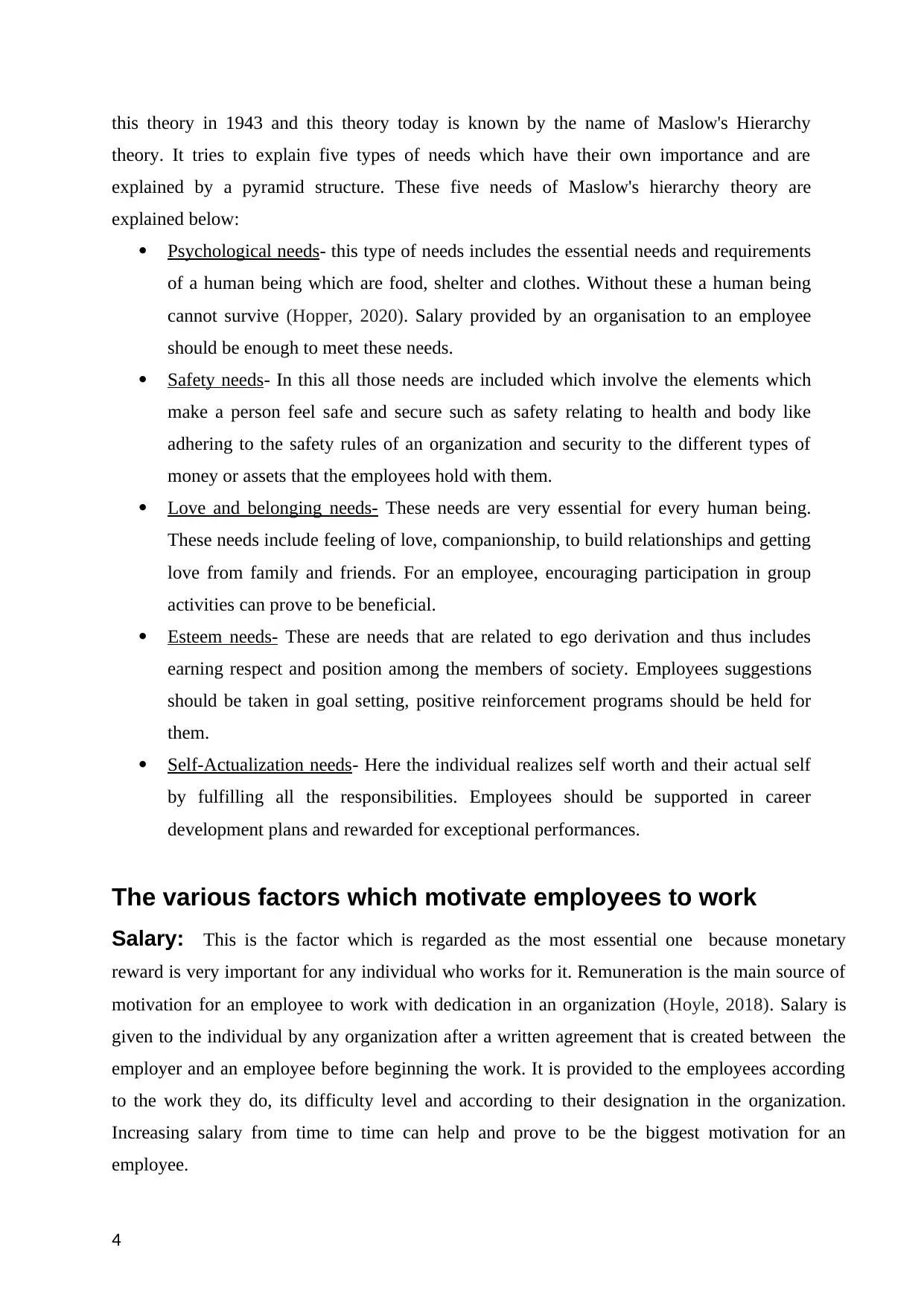
this theory in 1943 and this theory today is known by the name of Maslow's Hierarchy
theory. It tries to explain five types of needs which have their own importance and are
explained by a pyramid structure. These five needs of Maslow's hierarchy theory are
explained below:
Psychological needs- this type of needs includes the essential needs and requirements
of a human being which are food, shelter and clothes. Without these a human being
cannot survive (Hopper, 2020). Salary provided by an organisation to an employee
should be enough to meet these needs.
Safety needs- In this all those needs are included which involve the elements which
make a person feel safe and secure such as safety relating to health and body like
adhering to the safety rules of an organization and security to the different types of
money or assets that the employees hold with them.
Love and belonging needs- These needs are very essential for every human being.
These needs include feeling of love, companionship, to build relationships and getting
love from family and friends. For an employee, encouraging participation in group
activities can prove to be beneficial.
Esteem needs- These are needs that are related to ego derivation and thus includes
earning respect and position among the members of society. Employees suggestions
should be taken in goal setting, positive reinforcement programs should be held for
them.
Self-Actualization needs- Here the individual realizes self worth and their actual self
by fulfilling all the responsibilities. Employees should be supported in career
development plans and rewarded for exceptional performances.
The various factors which motivate employees to work
Salary: This is the factor which is regarded as the most essential one because monetary
reward is very important for any individual who works for it. Remuneration is the main source of
motivation for an employee to work with dedication in an organization (Hoyle, 2018). Salary is
given to the individual by any organization after a written agreement that is created between the
employer and an employee before beginning the work. It is provided to the employees according
to the work they do, its difficulty level and according to their designation in the organization.
Increasing salary from time to time can help and prove to be the biggest motivation for an
employee.
4
theory. It tries to explain five types of needs which have their own importance and are
explained by a pyramid structure. These five needs of Maslow's hierarchy theory are
explained below:
Psychological needs- this type of needs includes the essential needs and requirements
of a human being which are food, shelter and clothes. Without these a human being
cannot survive (Hopper, 2020). Salary provided by an organisation to an employee
should be enough to meet these needs.
Safety needs- In this all those needs are included which involve the elements which
make a person feel safe and secure such as safety relating to health and body like
adhering to the safety rules of an organization and security to the different types of
money or assets that the employees hold with them.
Love and belonging needs- These needs are very essential for every human being.
These needs include feeling of love, companionship, to build relationships and getting
love from family and friends. For an employee, encouraging participation in group
activities can prove to be beneficial.
Esteem needs- These are needs that are related to ego derivation and thus includes
earning respect and position among the members of society. Employees suggestions
should be taken in goal setting, positive reinforcement programs should be held for
them.
Self-Actualization needs- Here the individual realizes self worth and their actual self
by fulfilling all the responsibilities. Employees should be supported in career
development plans and rewarded for exceptional performances.
The various factors which motivate employees to work
Salary: This is the factor which is regarded as the most essential one because monetary
reward is very important for any individual who works for it. Remuneration is the main source of
motivation for an employee to work with dedication in an organization (Hoyle, 2018). Salary is
given to the individual by any organization after a written agreement that is created between the
employer and an employee before beginning the work. It is provided to the employees according
to the work they do, its difficulty level and according to their designation in the organization.
Increasing salary from time to time can help and prove to be the biggest motivation for an
employee.
4
Paraphrase This Document
Need a fresh take? Get an instant paraphrase of this document with our AI Paraphraser
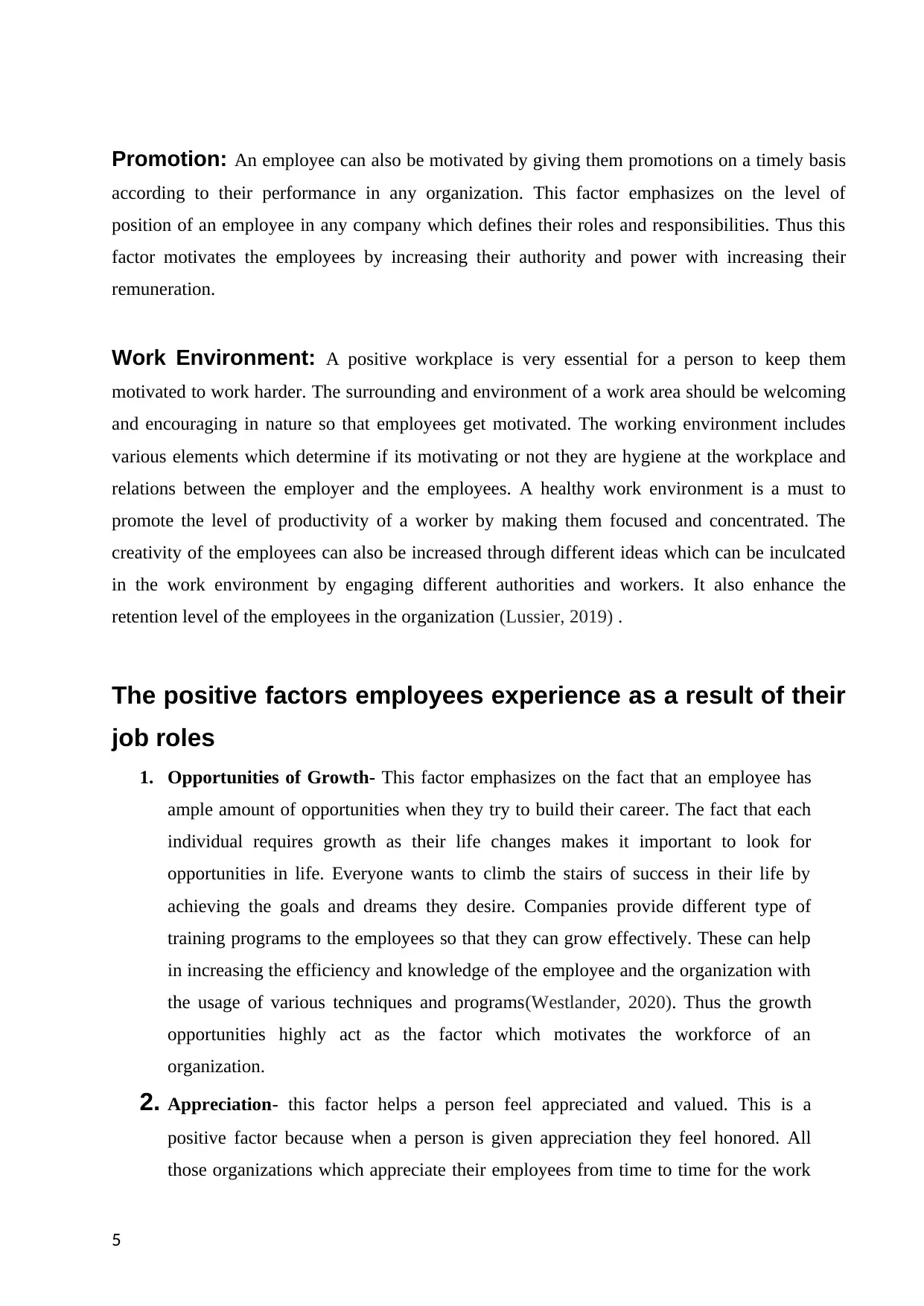
Promotion: An employee can also be motivated by giving them promotions on a timely basis
according to their performance in any organization. This factor emphasizes on the level of
position of an employee in any company which defines their roles and responsibilities. Thus this
factor motivates the employees by increasing their authority and power with increasing their
remuneration.
Work Environment: A positive workplace is very essential for a person to keep them
motivated to work harder. The surrounding and environment of a work area should be welcoming
and encouraging in nature so that employees get motivated. The working environment includes
various elements which determine if its motivating or not they are hygiene at the workplace and
relations between the employer and the employees. A healthy work environment is a must to
promote the level of productivity of a worker by making them focused and concentrated. The
creativity of the employees can also be increased through different ideas which can be inculcated
in the work environment by engaging different authorities and workers. It also enhance the
retention level of the employees in the organization (Lussier, 2019) .
The positive factors employees experience as a result of their
job roles
1. Opportunities of Growth- This factor emphasizes on the fact that an employee has
ample amount of opportunities when they try to build their career. The fact that each
individual requires growth as their life changes makes it important to look for
opportunities in life. Everyone wants to climb the stairs of success in their life by
achieving the goals and dreams they desire. Companies provide different type of
training programs to the employees so that they can grow effectively. These can help
in increasing the efficiency and knowledge of the employee and the organization with
the usage of various techniques and programs(Westlander, 2020). Thus the growth
opportunities highly act as the factor which motivates the workforce of an
organization.
2. Appreciation- this factor helps a person feel appreciated and valued. This is a
positive factor because when a person is given appreciation they feel honored. All
those organizations which appreciate their employees from time to time for the work
5
according to their performance in any organization. This factor emphasizes on the level of
position of an employee in any company which defines their roles and responsibilities. Thus this
factor motivates the employees by increasing their authority and power with increasing their
remuneration.
Work Environment: A positive workplace is very essential for a person to keep them
motivated to work harder. The surrounding and environment of a work area should be welcoming
and encouraging in nature so that employees get motivated. The working environment includes
various elements which determine if its motivating or not they are hygiene at the workplace and
relations between the employer and the employees. A healthy work environment is a must to
promote the level of productivity of a worker by making them focused and concentrated. The
creativity of the employees can also be increased through different ideas which can be inculcated
in the work environment by engaging different authorities and workers. It also enhance the
retention level of the employees in the organization (Lussier, 2019) .
The positive factors employees experience as a result of their
job roles
1. Opportunities of Growth- This factor emphasizes on the fact that an employee has
ample amount of opportunities when they try to build their career. The fact that each
individual requires growth as their life changes makes it important to look for
opportunities in life. Everyone wants to climb the stairs of success in their life by
achieving the goals and dreams they desire. Companies provide different type of
training programs to the employees so that they can grow effectively. These can help
in increasing the efficiency and knowledge of the employee and the organization with
the usage of various techniques and programs(Westlander, 2020). Thus the growth
opportunities highly act as the factor which motivates the workforce of an
organization.
2. Appreciation- this factor helps a person feel appreciated and valued. This is a
positive factor because when a person is given appreciation they feel honored. All
those organizations which appreciate their employees from time to time for the work
5
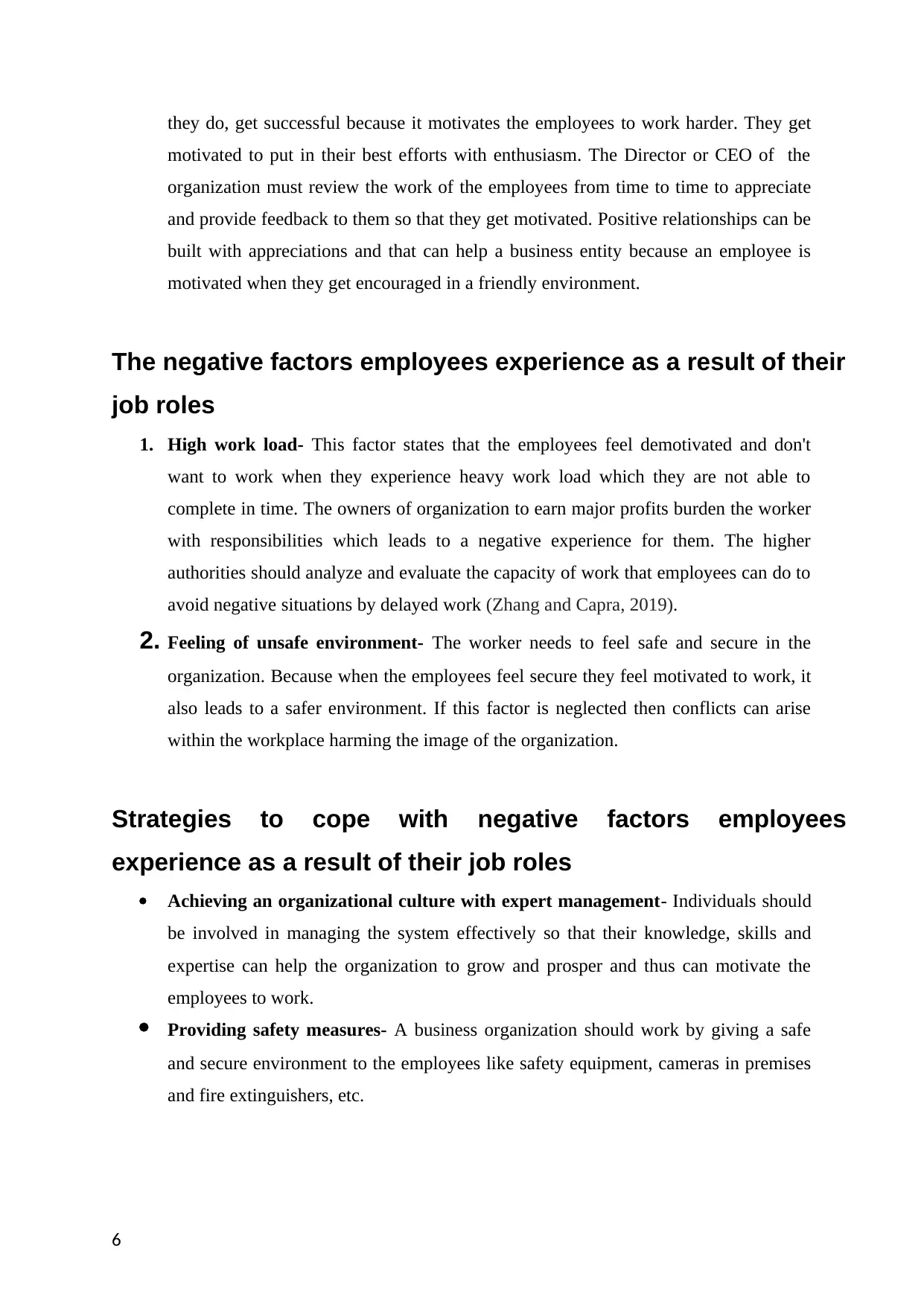
they do, get successful because it motivates the employees to work harder. They get
motivated to put in their best efforts with enthusiasm. The Director or CEO of the
organization must review the work of the employees from time to time to appreciate
and provide feedback to them so that they get motivated. Positive relationships can be
built with appreciations and that can help a business entity because an employee is
motivated when they get encouraged in a friendly environment.
The negative factors employees experience as a result of their
job roles
1. High work load- This factor states that the employees feel demotivated and don't
want to work when they experience heavy work load which they are not able to
complete in time. The owners of organization to earn major profits burden the worker
with responsibilities which leads to a negative experience for them. The higher
authorities should analyze and evaluate the capacity of work that employees can do to
avoid negative situations by delayed work (Zhang and Capra, 2019).
2. Feeling of unsafe environment- The worker needs to feel safe and secure in the
organization. Because when the employees feel secure they feel motivated to work, it
also leads to a safer environment. If this factor is neglected then conflicts can arise
within the workplace harming the image of the organization.
Strategies to cope with negative factors employees
experience as a result of their job roles
Achieving an organizational culture with expert management- Individuals should
be involved in managing the system effectively so that their knowledge, skills and
expertise can help the organization to grow and prosper and thus can motivate the
employees to work.
Providing safety measures- A business organization should work by giving a safe
and secure environment to the employees like safety equipment, cameras in premises
and fire extinguishers, etc.
6
motivated to put in their best efforts with enthusiasm. The Director or CEO of the
organization must review the work of the employees from time to time to appreciate
and provide feedback to them so that they get motivated. Positive relationships can be
built with appreciations and that can help a business entity because an employee is
motivated when they get encouraged in a friendly environment.
The negative factors employees experience as a result of their
job roles
1. High work load- This factor states that the employees feel demotivated and don't
want to work when they experience heavy work load which they are not able to
complete in time. The owners of organization to earn major profits burden the worker
with responsibilities which leads to a negative experience for them. The higher
authorities should analyze and evaluate the capacity of work that employees can do to
avoid negative situations by delayed work (Zhang and Capra, 2019).
2. Feeling of unsafe environment- The worker needs to feel safe and secure in the
organization. Because when the employees feel secure they feel motivated to work, it
also leads to a safer environment. If this factor is neglected then conflicts can arise
within the workplace harming the image of the organization.
Strategies to cope with negative factors employees
experience as a result of their job roles
Achieving an organizational culture with expert management- Individuals should
be involved in managing the system effectively so that their knowledge, skills and
expertise can help the organization to grow and prosper and thus can motivate the
employees to work.
Providing safety measures- A business organization should work by giving a safe
and secure environment to the employees like safety equipment, cameras in premises
and fire extinguishers, etc.
6
⊘ This is a preview!⊘
Do you want full access?
Subscribe today to unlock all pages.

Trusted by 1+ million students worldwide
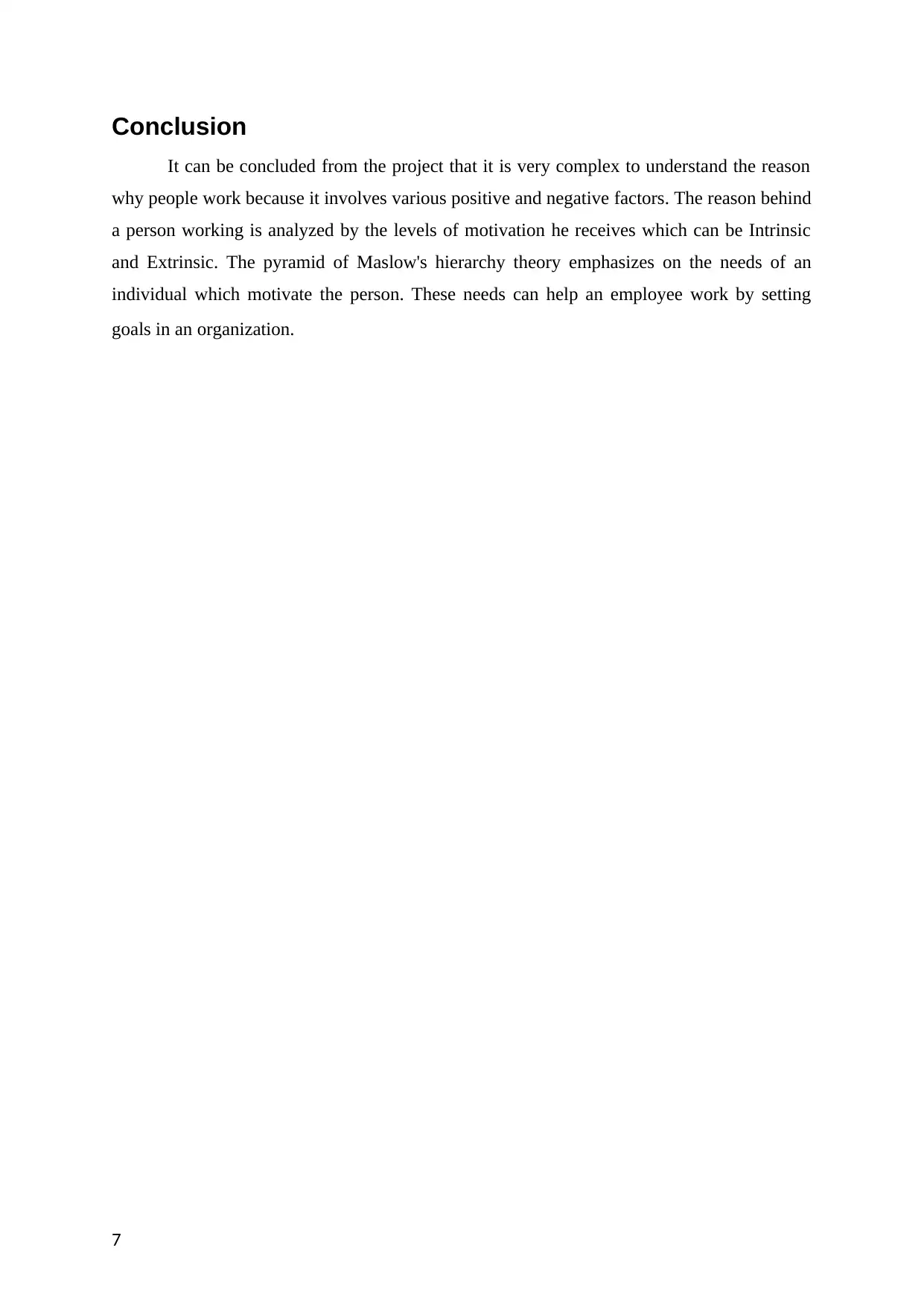
Conclusion
It can be concluded from the project that it is very complex to understand the reason
why people work because it involves various positive and negative factors. The reason behind
a person working is analyzed by the levels of motivation he receives which can be Intrinsic
and Extrinsic. The pyramid of Maslow's hierarchy theory emphasizes on the needs of an
individual which motivate the person. These needs can help an employee work by setting
goals in an organization.
7
It can be concluded from the project that it is very complex to understand the reason
why people work because it involves various positive and negative factors. The reason behind
a person working is analyzed by the levels of motivation he receives which can be Intrinsic
and Extrinsic. The pyramid of Maslow's hierarchy theory emphasizes on the needs of an
individual which motivate the person. These needs can help an employee work by setting
goals in an organization.
7
Paraphrase This Document
Need a fresh take? Get an instant paraphrase of this document with our AI Paraphraser
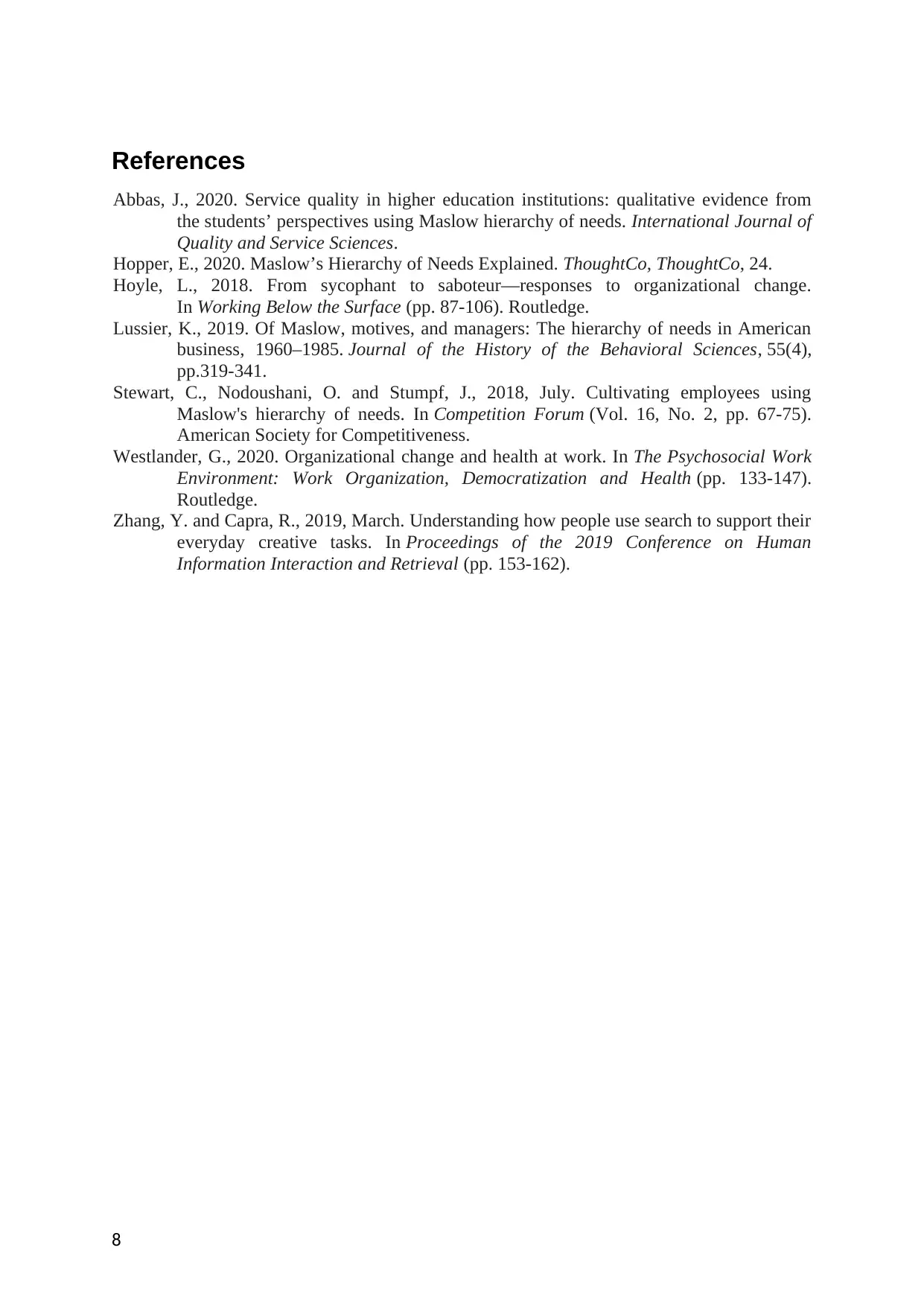
References
Abbas, J., 2020. Service quality in higher education institutions: qualitative evidence from
the students’ perspectives using Maslow hierarchy of needs. International Journal of
Quality and Service Sciences.
Hopper, E., 2020. Maslow’s Hierarchy of Needs Explained. ThoughtCo, ThoughtCo, 24.
Hoyle, L., 2018. From sycophant to saboteur—responses to organizational change.
In Working Below the Surface (pp. 87-106). Routledge.
Lussier, K., 2019. Of Maslow, motives, and managers: The hierarchy of needs in American
business, 1960–1985. Journal of the History of the Behavioral Sciences, 55(4),
pp.319-341.
Stewart, C., Nodoushani, O. and Stumpf, J., 2018, July. Cultivating employees using
Maslow's hierarchy of needs. In Competition Forum (Vol. 16, No. 2, pp. 67-75).
American Society for Competitiveness.
Westlander, G., 2020. Organizational change and health at work. In The Psychosocial Work
Environment: Work Organization, Democratization and Health (pp. 133-147).
Routledge.
Zhang, Y. and Capra, R., 2019, March. Understanding how people use search to support their
everyday creative tasks. In Proceedings of the 2019 Conference on Human
Information Interaction and Retrieval (pp. 153-162).
8
Abbas, J., 2020. Service quality in higher education institutions: qualitative evidence from
the students’ perspectives using Maslow hierarchy of needs. International Journal of
Quality and Service Sciences.
Hopper, E., 2020. Maslow’s Hierarchy of Needs Explained. ThoughtCo, ThoughtCo, 24.
Hoyle, L., 2018. From sycophant to saboteur—responses to organizational change.
In Working Below the Surface (pp. 87-106). Routledge.
Lussier, K., 2019. Of Maslow, motives, and managers: The hierarchy of needs in American
business, 1960–1985. Journal of the History of the Behavioral Sciences, 55(4),
pp.319-341.
Stewart, C., Nodoushani, O. and Stumpf, J., 2018, July. Cultivating employees using
Maslow's hierarchy of needs. In Competition Forum (Vol. 16, No. 2, pp. 67-75).
American Society for Competitiveness.
Westlander, G., 2020. Organizational change and health at work. In The Psychosocial Work
Environment: Work Organization, Democratization and Health (pp. 133-147).
Routledge.
Zhang, Y. and Capra, R., 2019, March. Understanding how people use search to support their
everyday creative tasks. In Proceedings of the 2019 Conference on Human
Information Interaction and Retrieval (pp. 153-162).
8
1 out of 8
Related Documents
Your All-in-One AI-Powered Toolkit for Academic Success.
+13062052269
info@desklib.com
Available 24*7 on WhatsApp / Email
![[object Object]](/_next/static/media/star-bottom.7253800d.svg)
Unlock your academic potential
Copyright © 2020–2025 A2Z Services. All Rights Reserved. Developed and managed by ZUCOL.




